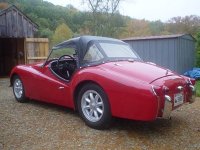NutmegCT
Experienced Member
If anyone's interested, last year I decided to "build" a mechanical television, based on the work of John Logie Baird (Scotland) in the late 1920s.
Fully mechanical scanning (Nipkow disc) with photocell at the camera and LED (couldn't find a usable neon bulb) at the receiver. Synchronized Nipkow discs provided the line scanning.
Here's a link to my original post on another forum:
http://www.britishcarforum.com/bcforum/ubbthreads.php/ubb/showflat/Number/390735/
I've been "into" old tech since I first built a mechanical TV back in 1965 when I was in highschool. Found the instructions in a 1927 issue of Science Newsletter.
What's the picture look like?

Tom
Fully mechanical scanning (Nipkow disc) with photocell at the camera and LED (couldn't find a usable neon bulb) at the receiver. Synchronized Nipkow discs provided the line scanning.
Here's a link to my original post on another forum:
http://www.britishcarforum.com/bcforum/ubbthreads.php/ubb/showflat/Number/390735/
I've been "into" old tech since I first built a mechanical TV back in 1965 when I was in highschool. Found the instructions in a 1927 issue of Science Newsletter.
What's the picture look like?

Tom



